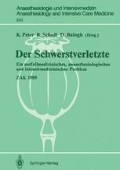Zusammenfassung
Während in den 60 er und frühen 70 er Jahren eine dramatische Zunahme von Streßblutungen beobachtet werden konnte, kam es in den letzten Jahren zu einer gegenläufigen Entwicklung [10]. Anfangs wurde diese Veränderung auf den routinemäßigen Einsatz medikamentöser präventiver Maßnahmen zurückgeführt. Die längerfristige Beobachtung der Streßblutungshäufigkeit machte jedoch deutlich, daß es auch unter der medikamentösen Prophylaxe zu einer weiteren Abnahme dieser Blutungskomplikation gekommen war [10]. Diese Tatsache konnte nicht mehr mit dem Einsatz der medikamentösen Prophylaxe erklärt werden, sondern mußte andere Ursachen haben. Diese dürften für den polytraumatisierten Patienten in einer verbesserten präklinischen, perioperativen und intensivmedizinischen Versorgung liegen. Notarztwagen und Rettungshubschrauber, adäquate Volumentherapie und frühzeitige Intubation sowie operative Versorgung unter optimierten anästhesiologi-schen Voraussetzungen, suffiziente Beatmung, Analgesie und Sedierung sowie frühestmögliche enterale Ernährung haben während des letzten Jahrzehnts wesentlich zur Verminderung von Streßblutungen beigetragen. Trotzdem beobachtet man auch heute noch bei besonderen Risikopatienten klinisch bedeutsame Streßblutungen.
Access this chapter
Tax calculation will be finalised at checkout
Purchases are for personal use only
Preview
Unable to display preview. Download preview PDF.
Literatur
Bailey RW, Bulkley GB, Hamilton SR, Morris JB, Haglund UH, Meilahn JE (1987) The fundamental hemodynamic mechanism underlying gastric stress ulceration in cardiogenic shock. Ann Surg 205:597–612
Breucha G, Daschner F, Eckart J, Hottenrott C, Klein HJ, Strasser K, Tryba M (1988) Interdisziplinäres Gesrpäch: Streßblutungsprophylaxe. Chirurgische Gastroenterologie mit interdisziplinären Gesprächen, Heft 2. TM-Verlag, Hameln, S 105–117
Hinder RA (1986) Stress ulceration: importance of blood flow and acid balance. Surg Ann 18:95–110
Koelz HR, Aeberhard P, Hassler H, Kunz H, Wagner HE, Roth F, Halter F (1987) Prophylactic treatment of acute gastroduodenal stress ulceration. Scand J Gastroenterol 22:1147–1152
Konturek SJ, Kwiecien N, Hebzda Z, Olesky J (1988) Stimulation of gastric alkaline secretion by gastroprotective drugs in man. Z Gastroenterol (Suppl 1) 26:27–30
Lunde OC, Kvernebo K, Larsen S (1988) Effect of pentagastrin and cimetdine on gastric blood flow measured by laser doppler flowmetry. Scand J Gastroenterol 23:151–157
Rees WDW (1987) Mucus-bicarbonate barrier - shield or sieve. Gut 28:1553–1556
Sales V, Delhon A, Tisne-Versailles J, Couzinier JP (1988) Cytoprotective activity of sucralfate, PGE2 and mucus synthesis. Gastroenterol Int (Suppl 1) 1:1020 (abstr)
Salomon A, Knapik Z, Zwolinski K, Paradowski L, Sierawski S (1988) The influence of pirenzepine and cimetidine on the function of the respiratory system in chronic lung diseases. Gastroenterol Int (Suppl 1) 1:123 (abstr)
lO.Schwedes U, Paschke R, Schiller M, Usadel KH (1986) Clinical effect of dopamine on incidence of peptic ulceration. Klin Wochenschr (Suppl VII) 64:128–131
Soderstrom CA, Ducker TB (1985) Increased susceptibility of patients with cervical cord lesions to peptic gastrointestinal complications. J Trauma 25:1030–1038
Stannard VA, Hutchinson A, Morris DL, Byrne A (1988) Gastric exocrine “failure” in critically ill patients: incidence and associated features. Br Med J 296:155–156
Tryba M (1987) Rationale Streßblutungsprophylaxe. Thieme, Stuttgart New York. INA-Reihe, Bd 59.
Tryba M (1988) Prevention of stress bleeding with ranitidine or pirenzepine and the risk of pneumonia. J Clin Anaesth 1:12–20
Tryba M (1989) Side effects of stress bleeding prophylaxis. Am J Med 86 (6A):85–94
Tryba M (1991) Der Einfluß präventiver Maßnahmen auf Morbidität und Mortalität von Intensivpatienten. Anästhesiol Intensivmed (im Druck)
Editor information
Editors and Affiliations
Rights and permissions
Copyright information
© 1991 Springer-Verlag Berlin Heidelberg
About this chapter
Cite this chapter
Tryba, M., Brand, J., Thole, H., Zenz, M. (1991). Streßblutungen bei Schwerverletzten — Pathophysiologie und Grundlagen der Prävention. In: Peter, K., Schedl, R., Balogh, D. (eds) Der Schwerstverletzte. Anaesthesiologie und Intensivmedizin / Anaesthesiology and Intensive Care Medicine, vol 220. Springer, Berlin, Heidelberg. https://doi.org/10.1007/978-3-642-76487-5_10
Download citation
DOI: https://doi.org/10.1007/978-3-642-76487-5_10
Publisher Name: Springer, Berlin, Heidelberg
Print ISBN: 978-3-540-53770-0
Online ISBN: 978-3-642-76487-5
eBook Packages: Springer Book Archive

